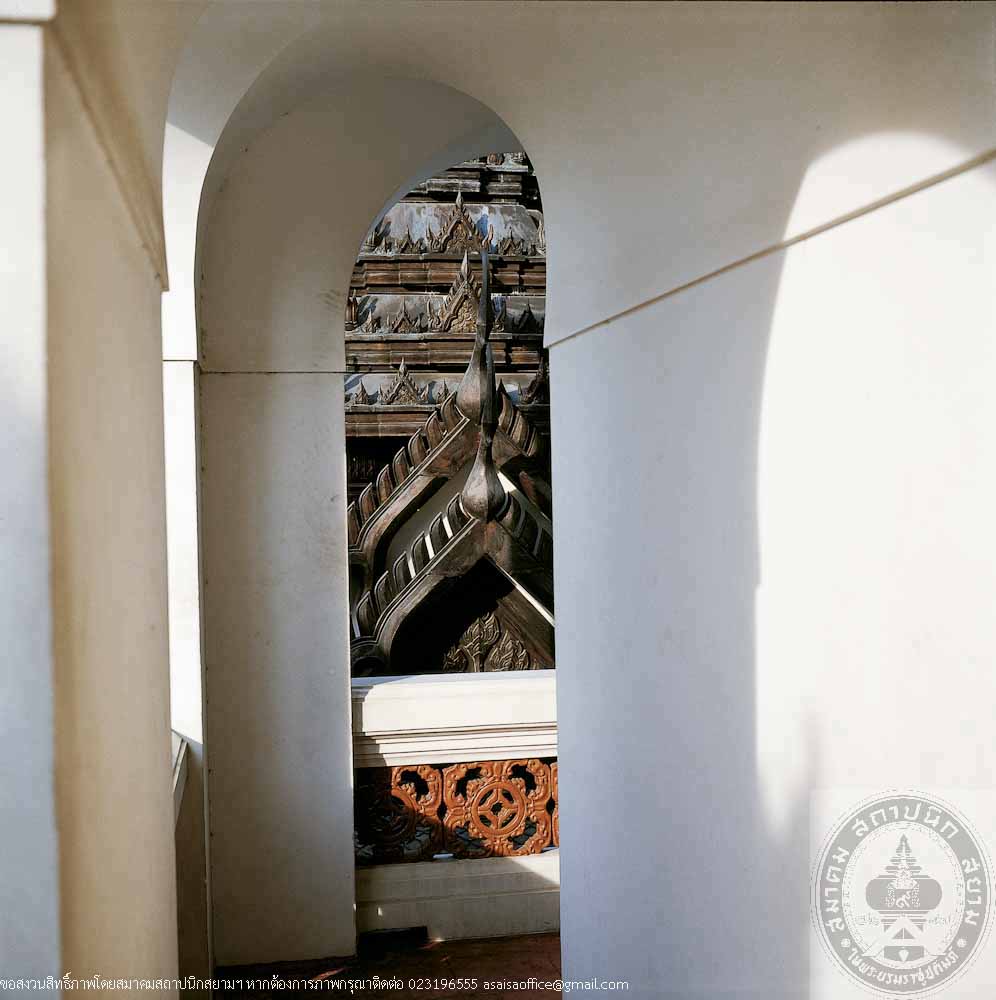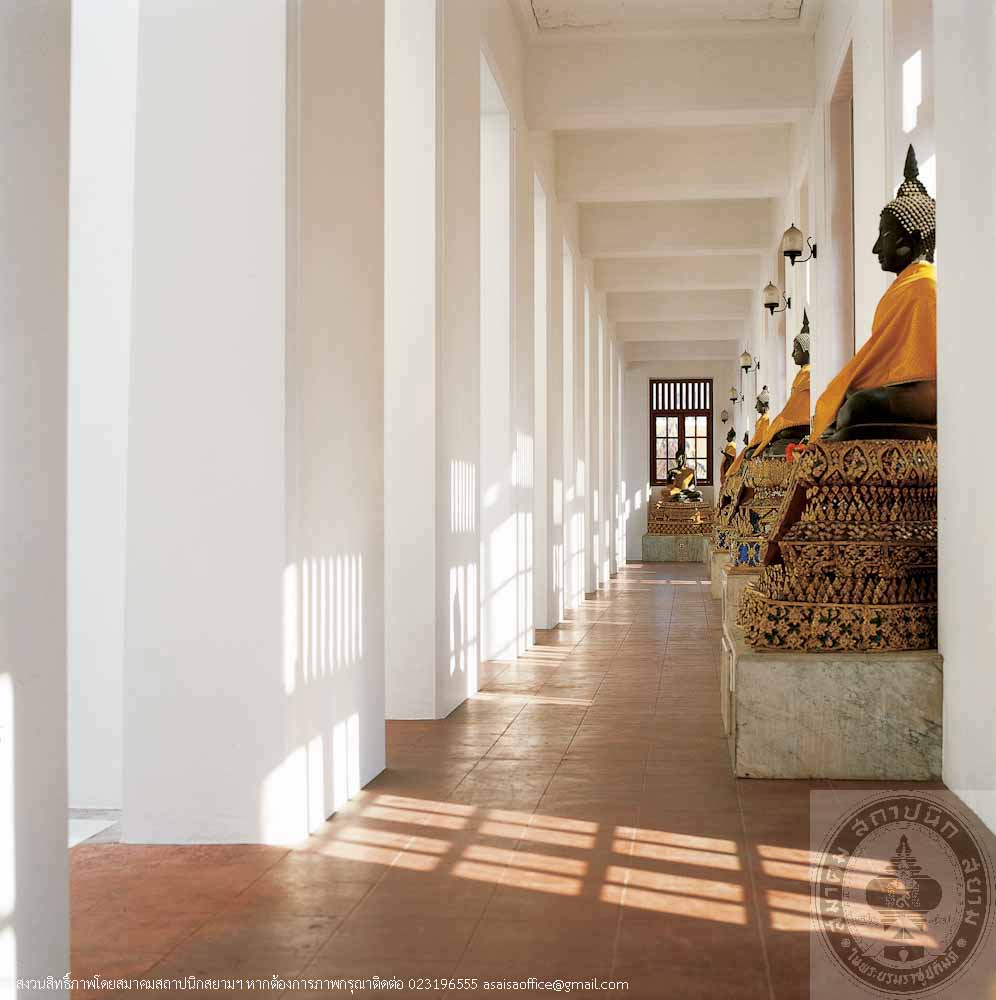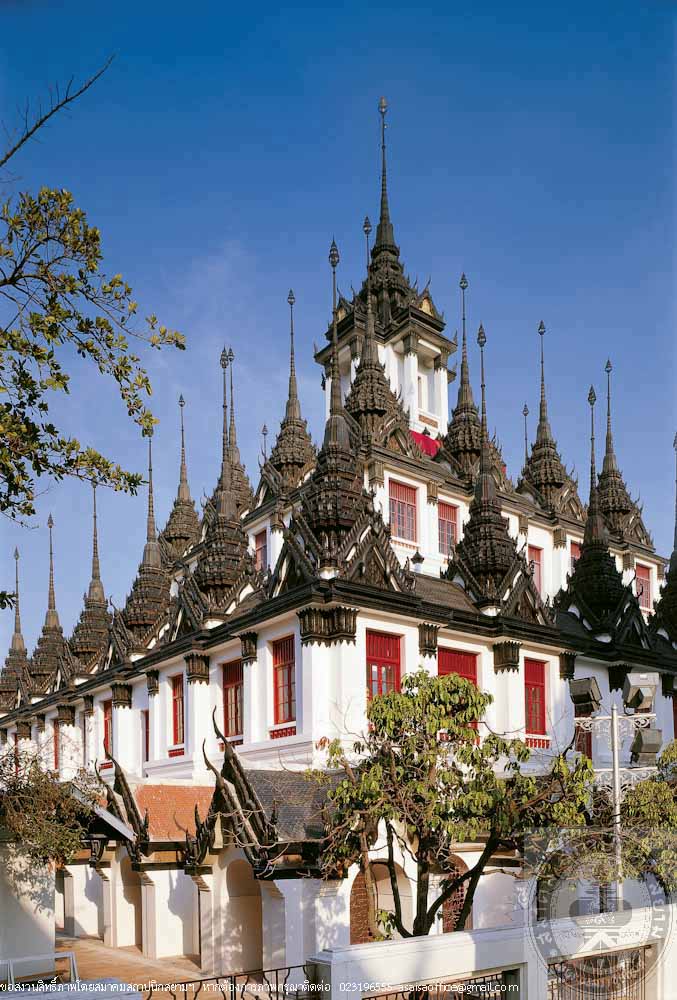โลหะปราสาท
โลหะปราสาท
ที่ตั้ง วัดราชนัดดารามวรวิหาร เลขที่ 2 ถนนมหาไชย แขวงสำราญราษฎร์ เขตพระนคร กรุงเทพมหานคร
ผู้ครอบครอง วัดราชนัดดารามวรวิหาร
ปีที่สร้าง พ.ศ. 2394
ปีที่ได้รับรางวัล พ.ศ. 2550
ประวัติ
วัดราชนัดดารามวรวิหาร เป็นพระอารามหลวงชั้นตรี พระบาทสมเด็จพระนั่งเกล้าเจ้าอยู่หัว รัชกาลที่ 3 ทรงพระกรุณา โปรดเกล้าโปรดกระหม่อมให้สร้างขึ้นเพื่อพระราชทานเป็นเกียรติแก่พระเจ้าหลานเธอ พระองค์เจ้าหญิงโสมนัสวัฒนาวดี ภายในวัดมีเสนาสนะต่างๆ แต่มีสิ่งก่อสร้างที่พิเศษมีเฉพาะที่พระอารามนี้คือ โลหะปราสาท ตั้งอยู่ด้านตะวันตกของพระอุโบสถ โลหะปราสาทหลังนี้สร้างขึ้นตามประวัติพระพุทธศาสนา นับเป็นโลหะปราสาทหลังที่ 3 ของโลก โดยโลหะปราสาทหลังแรก สร้างขึ้นในสมัยพุทธกาลโดยนางวิสาขามหาอุบาสิกาแห่งเมืองสาวัตถี โลหะปราสาทหลังที่ 2 สร้างโดยพระเจ้าทุฏฐคามณี กษัตริย์กรุง อนุราธปุระแห่งลังการาวปี พ.ศ. 382 ส่วนโลหะปราสาทวัดราชนัดดารามวรวิหาร เริ่มก่อสร้างในปี พ.ศ. 2394 แต่ก่อสร้างสำเร็จเป็นเพียงโกลนปราสาทก็สิ้นรัชกาล จนกระทั่งรัชสมัยพระบาทสมเด็จพระจุลจอมเกล้าเจ้าอยู่หัว รัชกาลที่ 5 พระประสิทธิ์สุตคุณ(แดง เขมทตฺโต) เจ้าอาวาส ได้ขอพระราชทานพระบรมราชานุญาตบูรณะปฏิสังขรณ์หลายครั้ง โดยบูรณะตั้งแต่ชั้นบนลงมาคือ ทำพื้น ก่อมณฑปโบกปูนสีแดง ยกฉัตรยอดเจดีย์ที่ชั้นบนสุดและชั้นที่ 2 ทั้งหมด ยังเหลือแต่ชั้นล่างสุดที่ไม่ได้บูรณะ
โลหะปราสาทวัดราชนัดดารามวรวิหาร มีลักษณะศิลปะสถาปัตยกรรมแบบไทย เป็นปราสาท 3 ชั้น มียอด 37 ยอด หมายถึงพระโพธิปักขิยธรรม 37 ประการ กลางปราสาทเป็นช่องกลวงจากฐานตลอดยอด มีซุงต้นใหญ่สูงถึงยอดปราสาท เป็นแกนกลาง เจาะลำต้นตอกเป็นบันไดเวียนขึ้น 67 ขั้น โลหะปราสาทขึ้นทะเบียนเป็นโบราณสถานในปี พ.ศ. 2492 แต่การบูรณะโลหะปราสาทครั้งใหญ่ ดำเนินการโดยพระราชปัญญาโสภณ (สุข ปุญญรํสี) เจ้าอาวาส โดยกรมโยธาเทศบาลเป็นผู้รับผิดชอบงานบูรณะในปี พ.ศ. 2506 ทั้งนี้ได้พยายามรักษาแบบแผนดั้งเดิมอย่างสมัยรัชกาลที่ 3 ไว้ให้มากที่สุดเท่าทำได้ นับว่าโลหะปราสาทได้บูรณปฏิสังขรณ์จนเสร็จสมบูรณ์ในครั้งนั้น ต่อมาเมื่อครั้งที่รัฐบาลจัดงานฉลองสิริราชสมบัติครบ 50 ปี
ระหว่างปี พ.ศ. 2538 – 2539 พระบาทสมเด็จพระเจ้าอยู่หัวทรงพระกรุณาโปรดเกล้าโปรดกระหม่อมเสด็จพระราชดำเนินมาทรงประดิษฐานพระบรมสารีริกธาตุ ณ พระเจดีย์บุษบกโลหะปราสาทเป็นพระราชพิธีแรกแห่งการทรงบำเพ็ญพระราชกุศลเมื่อวันที่ 27 กุมภาพันธ์ พ.ศ. 2538 สืบเนื่องจากวโรกาสดังกล่าว โครงการบูรณะล่าสุดจึงได้เกิดขึ้นในปี พ.ศ. 2539 เริ่มจากยอดมณฑปกลาง เปลี่ยนวัสดุมุงและเครื่องประดับหลังคาเป็นโลหะและทองแดงรมดำ โดยมีนาวาอากาศเอก อาวุธ เงินชูกลิ่น ศิลปินแห่งชาติเป็นสถาปนิกนายสุทิน เจริญสวัสดิ์ เป็นวิศวกรโยธา และนายประพิศ แก้วสุริยาควบคุมการก่อสร้างการบูรณปฏิสังขรณ์ได้ดำเนินการมาอย่างต่อเนื่อง ทำให้ยอดปราสาททุกยอดเป็นโลหะรมดำสมกับนามของอาคาร อีกทั้งตัวอาคารก็ได้บูรณะจนเรียบร้อยสมบูรณ์ ด้วยความร่วมมือร่วมใจของวัดราชนัดดารามวรวิหาร ภาครัฐ และภาคเอกชน โลหะปราสาทจึงได้รับการบูรณปฏิสังขรณ์อย่างสมบูรณ์ มีความสง่างาม เป็นความภาคภูมิใจของชาวไทยมาจนปัจจุบัน

โลหะปราสาท

โลหะปราสาท

โลหะปราสาท

โลหะปราสาท

โลหะปราสาท
-

โลหะปราสาท
-

โลหะปราสาท
-

โลหะปราสาท
-

โลหะปราสาท
-

โลหะปราสาท
Lohaprasat
Location 2 Mahachai Road, Khwaeng Samranrat, Khet Phra Nakhon, Bangkok Province
Proprietor Wat Ratchanaddaram Worawihan
Date of Construction 1851
Conservation Awarded 2007
History
Wat Ratchanaddaram Worawihan is a third class royal temple, registered as a National Monument on 22ndNovember, 1949. The temple was built by King Rama III tohonour his niece, H.H. Princess Somanatwatthanawadi (Queen Somanatwatthanawadiin the reign of King Rama IV). There are several beautiful buildings and structures in the temple grounds; however, the unique structure that can be found only at this temple is the Lohaprasat.
Lohaprasat is located to the west of the Ubosatha (Ordination Hall) built by initiation of King Rama III instead of a pagoda based on Buddhism history. This Lohaprast is the 3rd in the world that came after the first Lohaprasat built in the time of the Buddha by Lady Visakha Maha Ubasika, daughter of Thanachai Setthi of Sawatthi (Sravasti). The first Lohabprasat was called “Mikharamatuprasat”, with 2-storey, 1,000 rooms, and the spires were made of gold.
The 2nd Lohaprasat was built by King Dutthagamani (Dutugemunu) of Anuradhapura, Sri Lanka circa 382 B.E. (161 B.C.), as a 9-storey hall with 1,000 rooms, each side measured 50 metres in width and height, roofed with copper plates, the walls were wooden, decorated with gemstones and ivory.
The Lohaprasat of Wat Ratchanaddaram Worawihan has Thai architecture with 3-storey and 37 spires that represent the 37 Bodhipakkhiyadhamma (qualities contributing to or constituting enlightenment). The centre of the building is open, with a central structure made of an enormous log whose height reached to the top of the building; the log also acting as core of spiral stairs with 67 treads. The construction began in 1851, 5 years after the founding of Wat Ratchanaddaram. However, the building was only roughly finished when King Rama III passed away.
In the following reign of King Rama IV, no evidence of construction was found until the reign of King Rama V. Phra Prasitsuttakhun (Daeng Khemathatto) the Abbot, asked permission from the King to restore Lohaprasat, which was carried out in several phases. The restoration started from the top down and, Mandapa (spired hall) made of plastered brick, painted red, raising of the Chat (tiered umbrella) over the pagodas at the top and the second level. The only part that was yet to be restored was the ground floor.
Major restoration of Lohaprasat, however, was carried out later in the time of the Abbot Phra Ratchapanyasophon (Suk Punyarangsi), in collaboration with several government offices in 1963. The restoration aimed to conserve the original features of Lohaprasat in the reign of King Rama III. The work was carried out to completion by Department of Public and Municipal Works.
On the cerebration of 50th Anniversary of HM King Bhumibol Adulyadej’s Accession to the Throne held during 1995 – 1996. HM the King had the Ceremony of Enshrining the Buddha’s Relics in the Busabok Pagoda of Lohaprasat performed as the first ceremony in the period of celebrations. The Ceremony was presided over by the King on Monday 27thFebruary, 1995.
After the event, the latest Lohaprasat Restoration Project was conceived in 1996. The project consisted of restoration and reconstruction works starting from changingthe roofing materials and decorations of central roof spire to metal and black finished copper plates. The working team comprised Group Captain ArvuthNgoenchuklin, National Artist, project architect; Mr. Suthin Charoensawat, civil engineer; Mr. Praphit Kaeosuriya, foreman. The projects progressed continuously until all the spires have been replaced by black finished metal which is appropriate for the name “Lohaprasat” (“loha” means metal).
With cooperation between Wat Ratchanaddaram Worawihan, public andprivate sectors, the conservation of Lohaprasat has reached its completion successfully.